Holistic Assessment Project: Risk Management Techniques
VerifiedAdded on 2023/06/12
|9
|1918
|431
Report
AI Summary
This report provides a holistic assessment of risk management in various projects, detailing techniques for risk identification, analysis, and control. It covers strategies such as risk avoidance, transfer, and loss reduction, alongside tools like threat analysis and portfolio risk assessment. The report also examines the application of risk management in identifying hazards, particularly in relation to Occupational Health and Safety (OHS), emphasizing the importance of assessment, control, and product implementation to mitigate risks and ensure workplace safety. The document is available on Desklib, a platform offering a wide range of study tools and solved assignments for students.
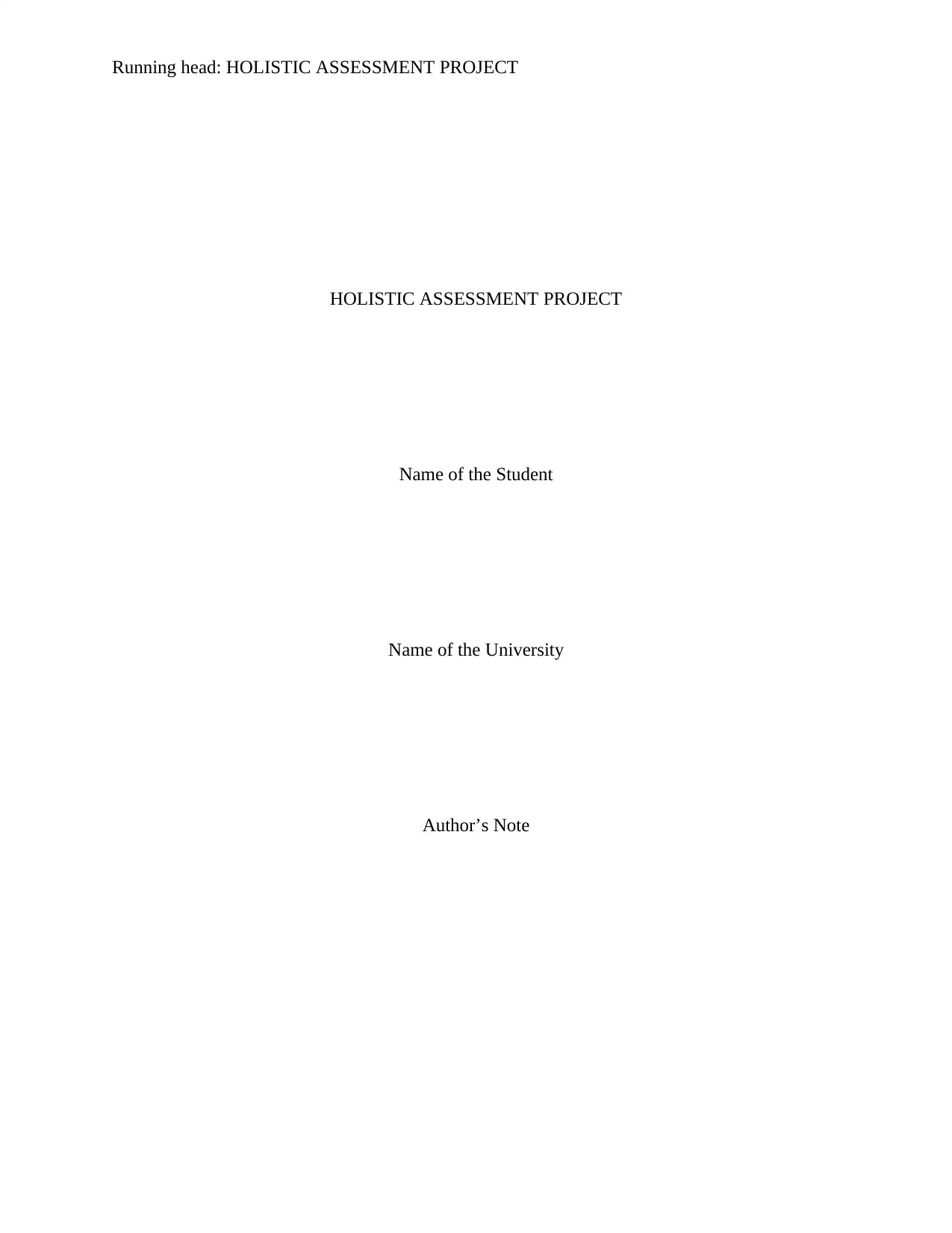
Running head: HOLISTIC ASSESSMENT PROJECT
HOLISTIC ASSESSMENT PROJECT
Name of the Student
Name of the University
Author’s Note
HOLISTIC ASSESSMENT PROJECT
Name of the Student
Name of the University
Author’s Note
Paraphrase This Document
Need a fresh take? Get an instant paraphrase of this document with our AI Paraphraser
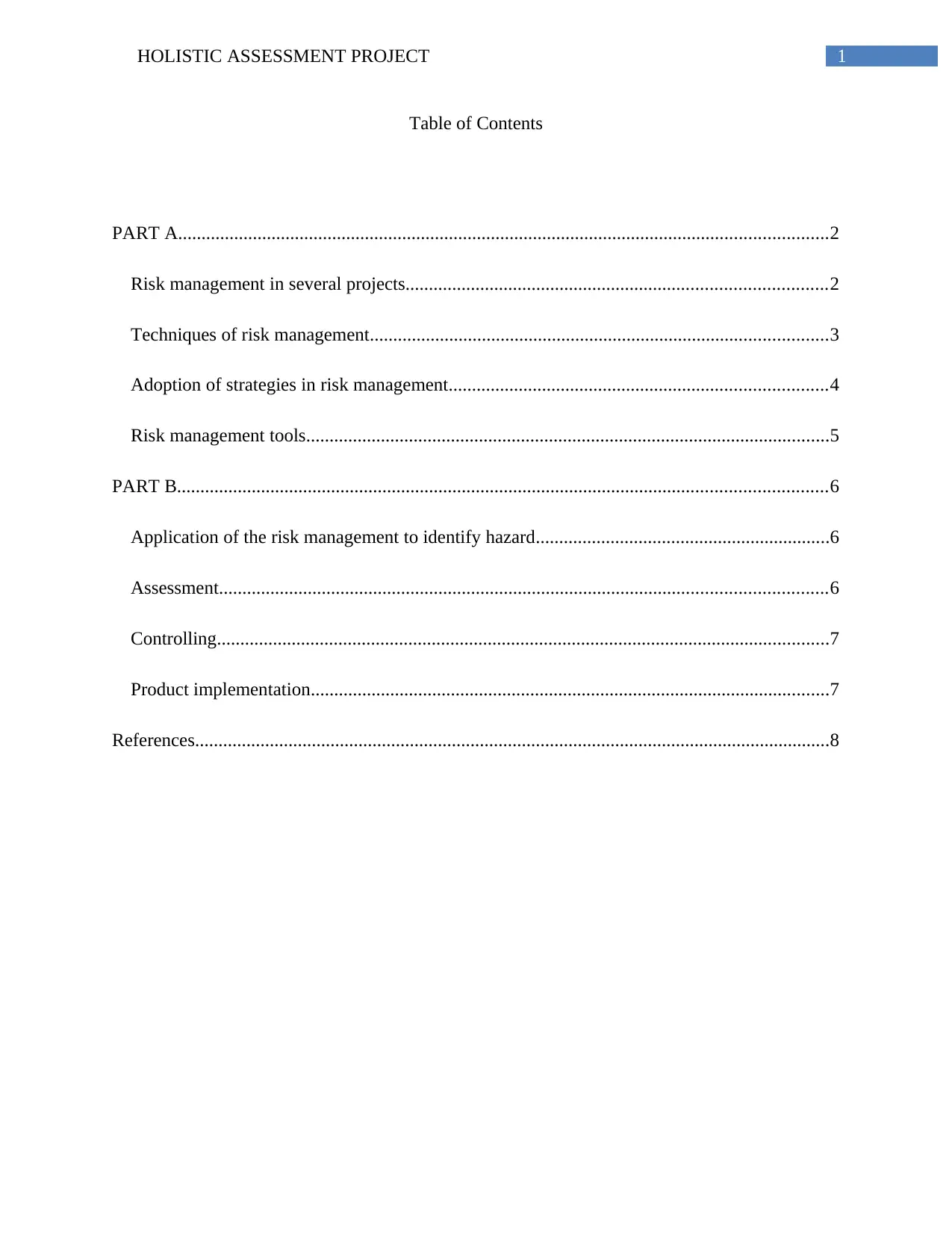
1HOLISTIC ASSESSMENT PROJECT
Table of Contents
PART A...........................................................................................................................................2
Risk management in several projects..........................................................................................2
Techniques of risk management..................................................................................................3
Adoption of strategies in risk management.................................................................................4
Risk management tools................................................................................................................5
PART B...........................................................................................................................................6
Application of the risk management to identify hazard...............................................................6
Assessment..................................................................................................................................6
Controlling...................................................................................................................................7
Product implementation...............................................................................................................7
References........................................................................................................................................8
Table of Contents
PART A...........................................................................................................................................2
Risk management in several projects..........................................................................................2
Techniques of risk management..................................................................................................3
Adoption of strategies in risk management.................................................................................4
Risk management tools................................................................................................................5
PART B...........................................................................................................................................6
Application of the risk management to identify hazard...............................................................6
Assessment..................................................................................................................................6
Controlling...................................................................................................................................7
Product implementation...............................................................................................................7
References........................................................................................................................................8
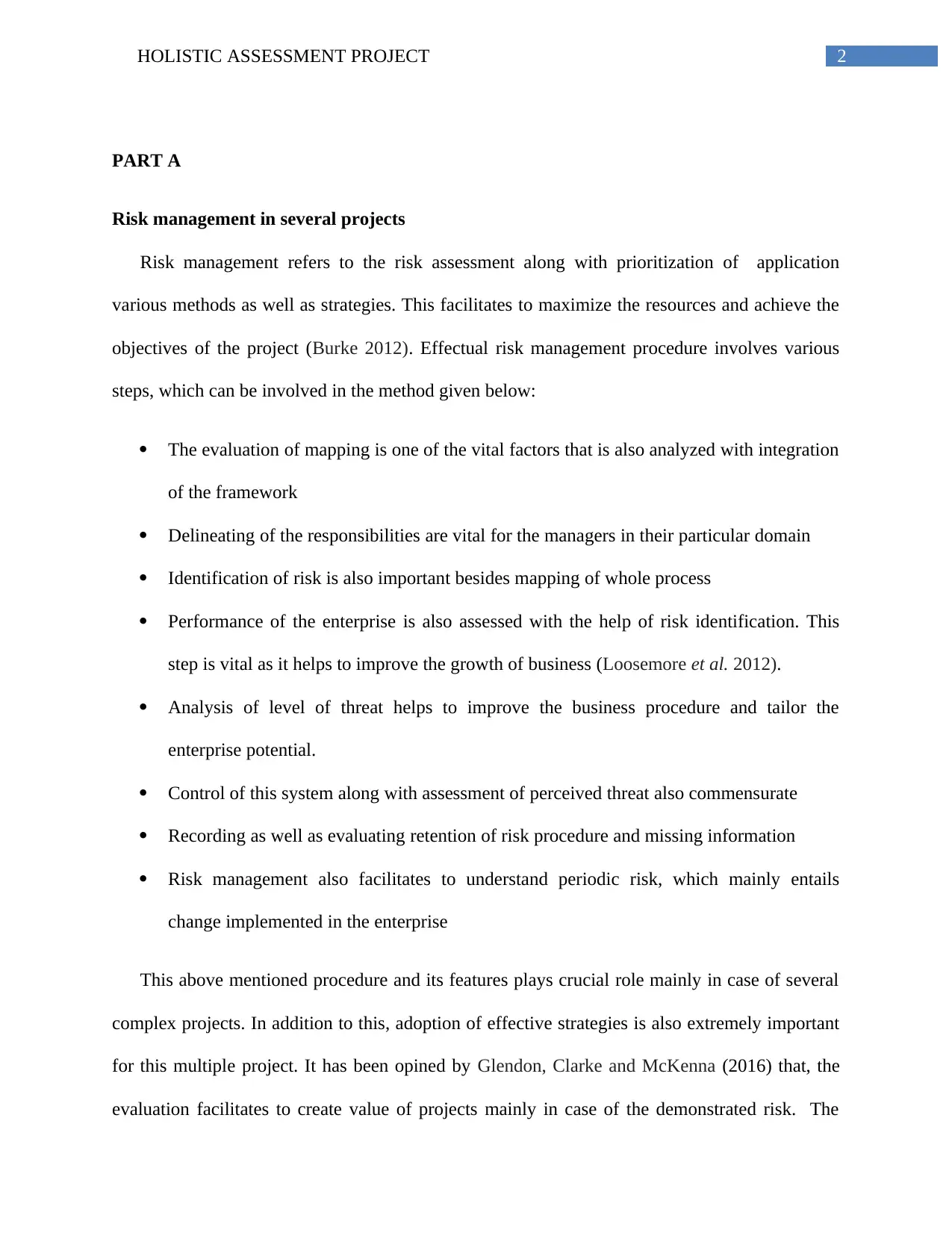
2HOLISTIC ASSESSMENT PROJECT
PART A
Risk management in several projects
Risk management refers to the risk assessment along with prioritization of application
various methods as well as strategies. This facilitates to maximize the resources and achieve the
objectives of the project (Burke 2012). Effectual risk management procedure involves various
steps, which can be involved in the method given below:
The evaluation of mapping is one of the vital factors that is also analyzed with integration
of the framework
Delineating of the responsibilities are vital for the managers in their particular domain
Identification of risk is also important besides mapping of whole process
Performance of the enterprise is also assessed with the help of risk identification. This
step is vital as it helps to improve the growth of business (Loosemore et al. 2012).
Analysis of level of threat helps to improve the business procedure and tailor the
enterprise potential.
Control of this system along with assessment of perceived threat also commensurate
Recording as well as evaluating retention of risk procedure and missing information
Risk management also facilitates to understand periodic risk, which mainly entails
change implemented in the enterprise
This above mentioned procedure and its features plays crucial role mainly in case of several
complex projects. In addition to this, adoption of effective strategies is also extremely important
for this multiple project. It has been opined by Glendon, Clarke and McKenna (2016) that, the
evaluation facilitates to create value of projects mainly in case of the demonstrated risk. The
PART A
Risk management in several projects
Risk management refers to the risk assessment along with prioritization of application
various methods as well as strategies. This facilitates to maximize the resources and achieve the
objectives of the project (Burke 2012). Effectual risk management procedure involves various
steps, which can be involved in the method given below:
The evaluation of mapping is one of the vital factors that is also analyzed with integration
of the framework
Delineating of the responsibilities are vital for the managers in their particular domain
Identification of risk is also important besides mapping of whole process
Performance of the enterprise is also assessed with the help of risk identification. This
step is vital as it helps to improve the growth of business (Loosemore et al. 2012).
Analysis of level of threat helps to improve the business procedure and tailor the
enterprise potential.
Control of this system along with assessment of perceived threat also commensurate
Recording as well as evaluating retention of risk procedure and missing information
Risk management also facilitates to understand periodic risk, which mainly entails
change implemented in the enterprise
This above mentioned procedure and its features plays crucial role mainly in case of several
complex projects. In addition to this, adoption of effective strategies is also extremely important
for this multiple project. It has been opined by Glendon, Clarke and McKenna (2016) that, the
evaluation facilitates to create value of projects mainly in case of the demonstrated risk. The
⊘ This is a preview!⊘
Do you want full access?
Subscribe today to unlock all pages.

Trusted by 1+ million students worldwide
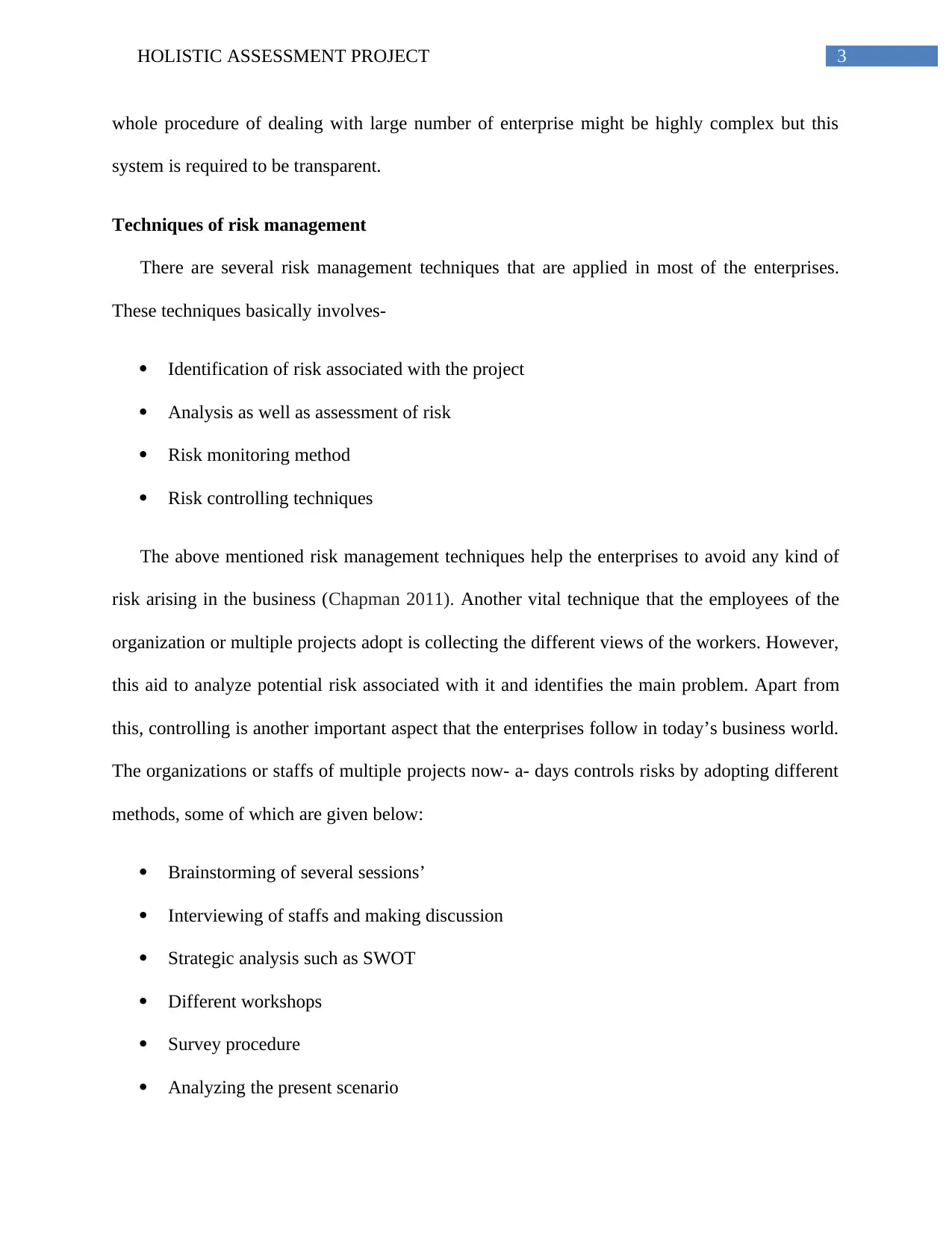
3HOLISTIC ASSESSMENT PROJECT
whole procedure of dealing with large number of enterprise might be highly complex but this
system is required to be transparent.
Techniques of risk management
There are several risk management techniques that are applied in most of the enterprises.
These techniques basically involves-
Identification of risk associated with the project
Analysis as well as assessment of risk
Risk monitoring method
Risk controlling techniques
The above mentioned risk management techniques help the enterprises to avoid any kind of
risk arising in the business (Chapman 2011). Another vital technique that the employees of the
organization or multiple projects adopt is collecting the different views of the workers. However,
this aid to analyze potential risk associated with it and identifies the main problem. Apart from
this, controlling is another important aspect that the enterprises follow in today’s business world.
The organizations or staffs of multiple projects now- a- days controls risks by adopting different
methods, some of which are given below:
Brainstorming of several sessions’
Interviewing of staffs and making discussion
Strategic analysis such as SWOT
Different workshops
Survey procedure
Analyzing the present scenario
whole procedure of dealing with large number of enterprise might be highly complex but this
system is required to be transparent.
Techniques of risk management
There are several risk management techniques that are applied in most of the enterprises.
These techniques basically involves-
Identification of risk associated with the project
Analysis as well as assessment of risk
Risk monitoring method
Risk controlling techniques
The above mentioned risk management techniques help the enterprises to avoid any kind of
risk arising in the business (Chapman 2011). Another vital technique that the employees of the
organization or multiple projects adopt is collecting the different views of the workers. However,
this aid to analyze potential risk associated with it and identifies the main problem. Apart from
this, controlling is another important aspect that the enterprises follow in today’s business world.
The organizations or staffs of multiple projects now- a- days controls risks by adopting different
methods, some of which are given below:
Brainstorming of several sessions’
Interviewing of staffs and making discussion
Strategic analysis such as SWOT
Different workshops
Survey procedure
Analyzing the present scenario
Paraphrase This Document
Need a fresh take? Get an instant paraphrase of this document with our AI Paraphraser
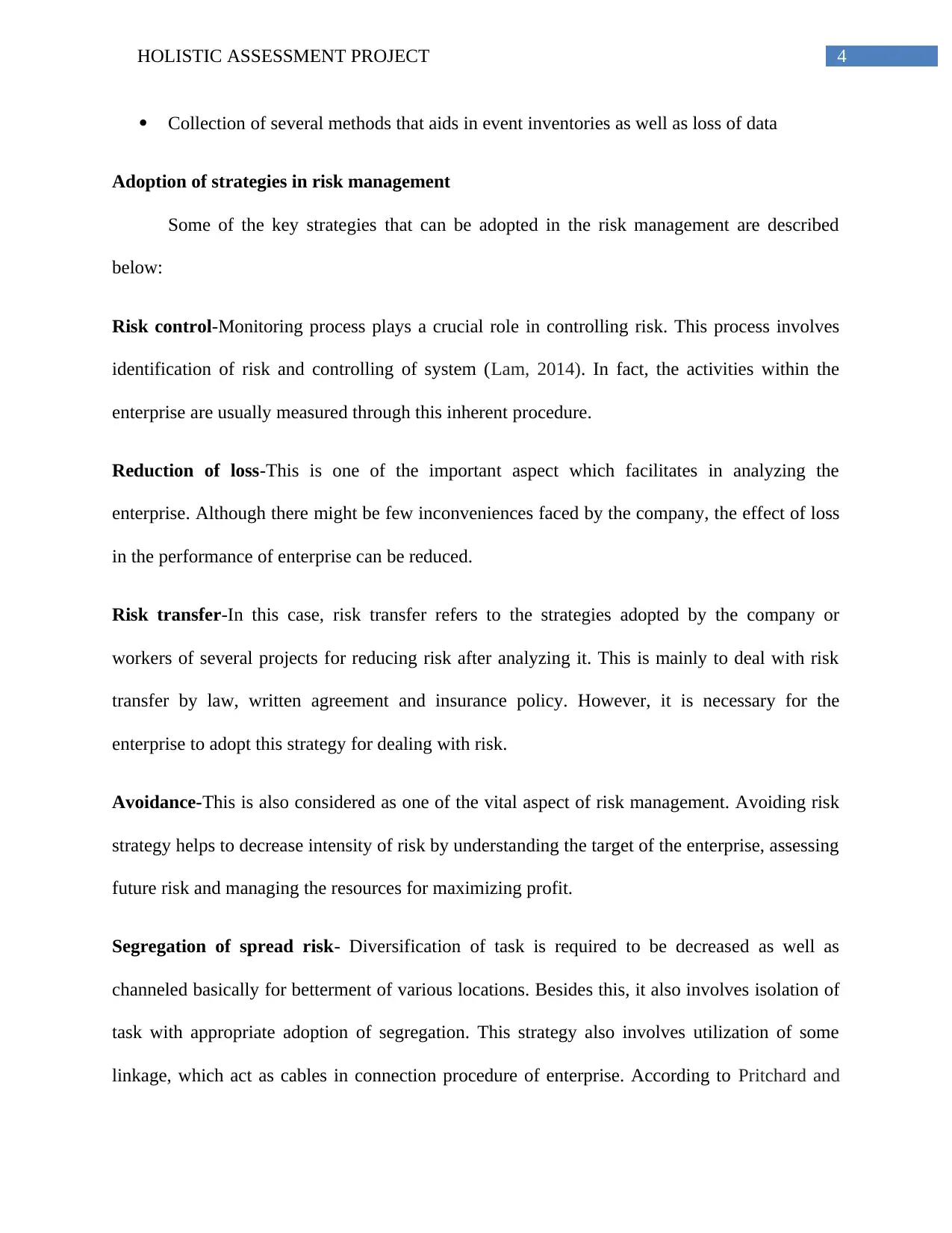
4HOLISTIC ASSESSMENT PROJECT
Collection of several methods that aids in event inventories as well as loss of data
Adoption of strategies in risk management
Some of the key strategies that can be adopted in the risk management are described
below:
Risk control-Monitoring process plays a crucial role in controlling risk. This process involves
identification of risk and controlling of system (Lam, 2014). In fact, the activities within the
enterprise are usually measured through this inherent procedure.
Reduction of loss-This is one of the important aspect which facilitates in analyzing the
enterprise. Although there might be few inconveniences faced by the company, the effect of loss
in the performance of enterprise can be reduced.
Risk transfer-In this case, risk transfer refers to the strategies adopted by the company or
workers of several projects for reducing risk after analyzing it. This is mainly to deal with risk
transfer by law, written agreement and insurance policy. However, it is necessary for the
enterprise to adopt this strategy for dealing with risk.
Avoidance-This is also considered as one of the vital aspect of risk management. Avoiding risk
strategy helps to decrease intensity of risk by understanding the target of the enterprise, assessing
future risk and managing the resources for maximizing profit.
Segregation of spread risk- Diversification of task is required to be decreased as well as
channeled basically for betterment of various locations. Besides this, it also involves isolation of
task with appropriate adoption of segregation. This strategy also involves utilization of some
linkage, which act as cables in connection procedure of enterprise. According to Pritchard and
Collection of several methods that aids in event inventories as well as loss of data
Adoption of strategies in risk management
Some of the key strategies that can be adopted in the risk management are described
below:
Risk control-Monitoring process plays a crucial role in controlling risk. This process involves
identification of risk and controlling of system (Lam, 2014). In fact, the activities within the
enterprise are usually measured through this inherent procedure.
Reduction of loss-This is one of the important aspect which facilitates in analyzing the
enterprise. Although there might be few inconveniences faced by the company, the effect of loss
in the performance of enterprise can be reduced.
Risk transfer-In this case, risk transfer refers to the strategies adopted by the company or
workers of several projects for reducing risk after analyzing it. This is mainly to deal with risk
transfer by law, written agreement and insurance policy. However, it is necessary for the
enterprise to adopt this strategy for dealing with risk.
Avoidance-This is also considered as one of the vital aspect of risk management. Avoiding risk
strategy helps to decrease intensity of risk by understanding the target of the enterprise, assessing
future risk and managing the resources for maximizing profit.
Segregation of spread risk- Diversification of task is required to be decreased as well as
channeled basically for betterment of various locations. Besides this, it also involves isolation of
task with appropriate adoption of segregation. This strategy also involves utilization of some
linkage, which act as cables in connection procedure of enterprise. According to Pritchard and
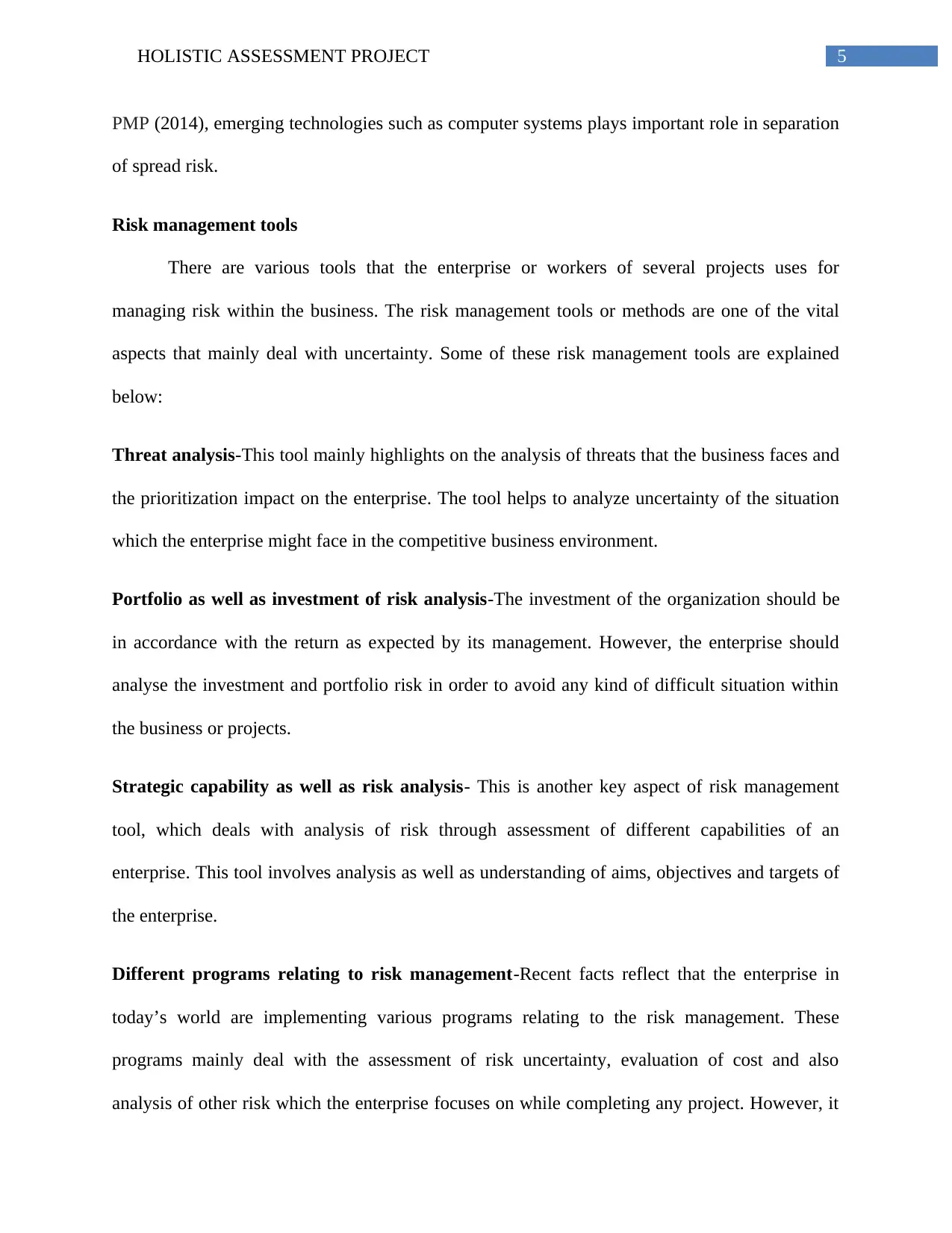
5HOLISTIC ASSESSMENT PROJECT
PMP (2014), emerging technologies such as computer systems plays important role in separation
of spread risk.
Risk management tools
There are various tools that the enterprise or workers of several projects uses for
managing risk within the business. The risk management tools or methods are one of the vital
aspects that mainly deal with uncertainty. Some of these risk management tools are explained
below:
Threat analysis-This tool mainly highlights on the analysis of threats that the business faces and
the prioritization impact on the enterprise. The tool helps to analyze uncertainty of the situation
which the enterprise might face in the competitive business environment.
Portfolio as well as investment of risk analysis-The investment of the organization should be
in accordance with the return as expected by its management. However, the enterprise should
analyse the investment and portfolio risk in order to avoid any kind of difficult situation within
the business or projects.
Strategic capability as well as risk analysis- This is another key aspect of risk management
tool, which deals with analysis of risk through assessment of different capabilities of an
enterprise. This tool involves analysis as well as understanding of aims, objectives and targets of
the enterprise.
Different programs relating to risk management-Recent facts reflect that the enterprise in
today’s world are implementing various programs relating to the risk management. These
programs mainly deal with the assessment of risk uncertainty, evaluation of cost and also
analysis of other risk which the enterprise focuses on while completing any project. However, it
PMP (2014), emerging technologies such as computer systems plays important role in separation
of spread risk.
Risk management tools
There are various tools that the enterprise or workers of several projects uses for
managing risk within the business. The risk management tools or methods are one of the vital
aspects that mainly deal with uncertainty. Some of these risk management tools are explained
below:
Threat analysis-This tool mainly highlights on the analysis of threats that the business faces and
the prioritization impact on the enterprise. The tool helps to analyze uncertainty of the situation
which the enterprise might face in the competitive business environment.
Portfolio as well as investment of risk analysis-The investment of the organization should be
in accordance with the return as expected by its management. However, the enterprise should
analyse the investment and portfolio risk in order to avoid any kind of difficult situation within
the business or projects.
Strategic capability as well as risk analysis- This is another key aspect of risk management
tool, which deals with analysis of risk through assessment of different capabilities of an
enterprise. This tool involves analysis as well as understanding of aims, objectives and targets of
the enterprise.
Different programs relating to risk management-Recent facts reflect that the enterprise in
today’s world are implementing various programs relating to the risk management. These
programs mainly deal with the assessment of risk uncertainty, evaluation of cost and also
analysis of other risk which the enterprise focuses on while completing any project. However, it
⊘ This is a preview!⊘
Do you want full access?
Subscribe today to unlock all pages.

Trusted by 1+ million students worldwide
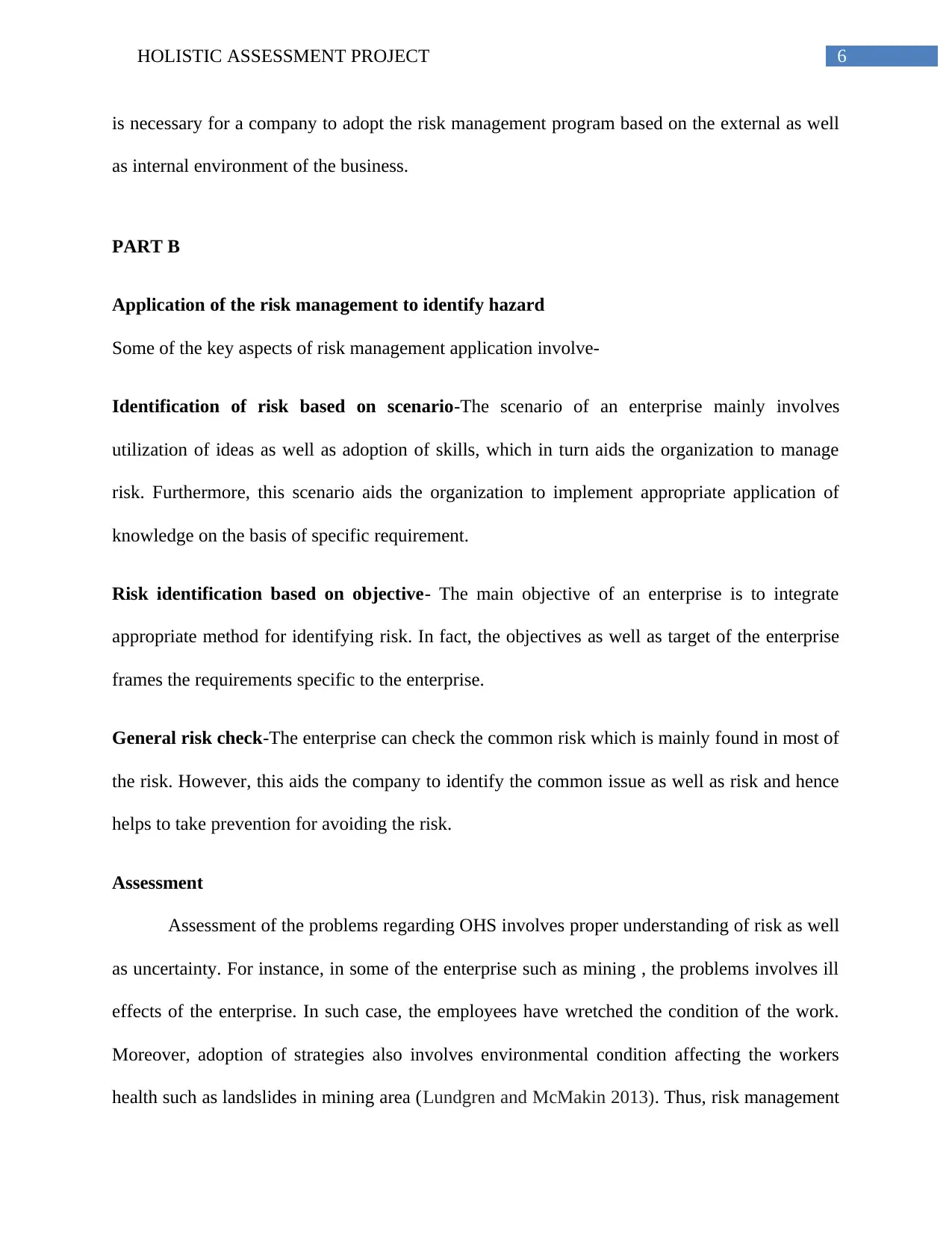
6HOLISTIC ASSESSMENT PROJECT
is necessary for a company to adopt the risk management program based on the external as well
as internal environment of the business.
PART B
Application of the risk management to identify hazard
Some of the key aspects of risk management application involve-
Identification of risk based on scenario-The scenario of an enterprise mainly involves
utilization of ideas as well as adoption of skills, which in turn aids the organization to manage
risk. Furthermore, this scenario aids the organization to implement appropriate application of
knowledge on the basis of specific requirement.
Risk identification based on objective- The main objective of an enterprise is to integrate
appropriate method for identifying risk. In fact, the objectives as well as target of the enterprise
frames the requirements specific to the enterprise.
General risk check-The enterprise can check the common risk which is mainly found in most of
the risk. However, this aids the company to identify the common issue as well as risk and hence
helps to take prevention for avoiding the risk.
Assessment
Assessment of the problems regarding OHS involves proper understanding of risk as well
as uncertainty. For instance, in some of the enterprise such as mining , the problems involves ill
effects of the enterprise. In such case, the employees have wretched the condition of the work.
Moreover, adoption of strategies also involves environmental condition affecting the workers
health such as landslides in mining area (Lundgren and McMakin 2013). Thus, risk management
is necessary for a company to adopt the risk management program based on the external as well
as internal environment of the business.
PART B
Application of the risk management to identify hazard
Some of the key aspects of risk management application involve-
Identification of risk based on scenario-The scenario of an enterprise mainly involves
utilization of ideas as well as adoption of skills, which in turn aids the organization to manage
risk. Furthermore, this scenario aids the organization to implement appropriate application of
knowledge on the basis of specific requirement.
Risk identification based on objective- The main objective of an enterprise is to integrate
appropriate method for identifying risk. In fact, the objectives as well as target of the enterprise
frames the requirements specific to the enterprise.
General risk check-The enterprise can check the common risk which is mainly found in most of
the risk. However, this aids the company to identify the common issue as well as risk and hence
helps to take prevention for avoiding the risk.
Assessment
Assessment of the problems regarding OHS involves proper understanding of risk as well
as uncertainty. For instance, in some of the enterprise such as mining , the problems involves ill
effects of the enterprise. In such case, the employees have wretched the condition of the work.
Moreover, adoption of strategies also involves environmental condition affecting the workers
health such as landslides in mining area (Lundgren and McMakin 2013). Thus, risk management
Paraphrase This Document
Need a fresh take? Get an instant paraphrase of this document with our AI Paraphraser
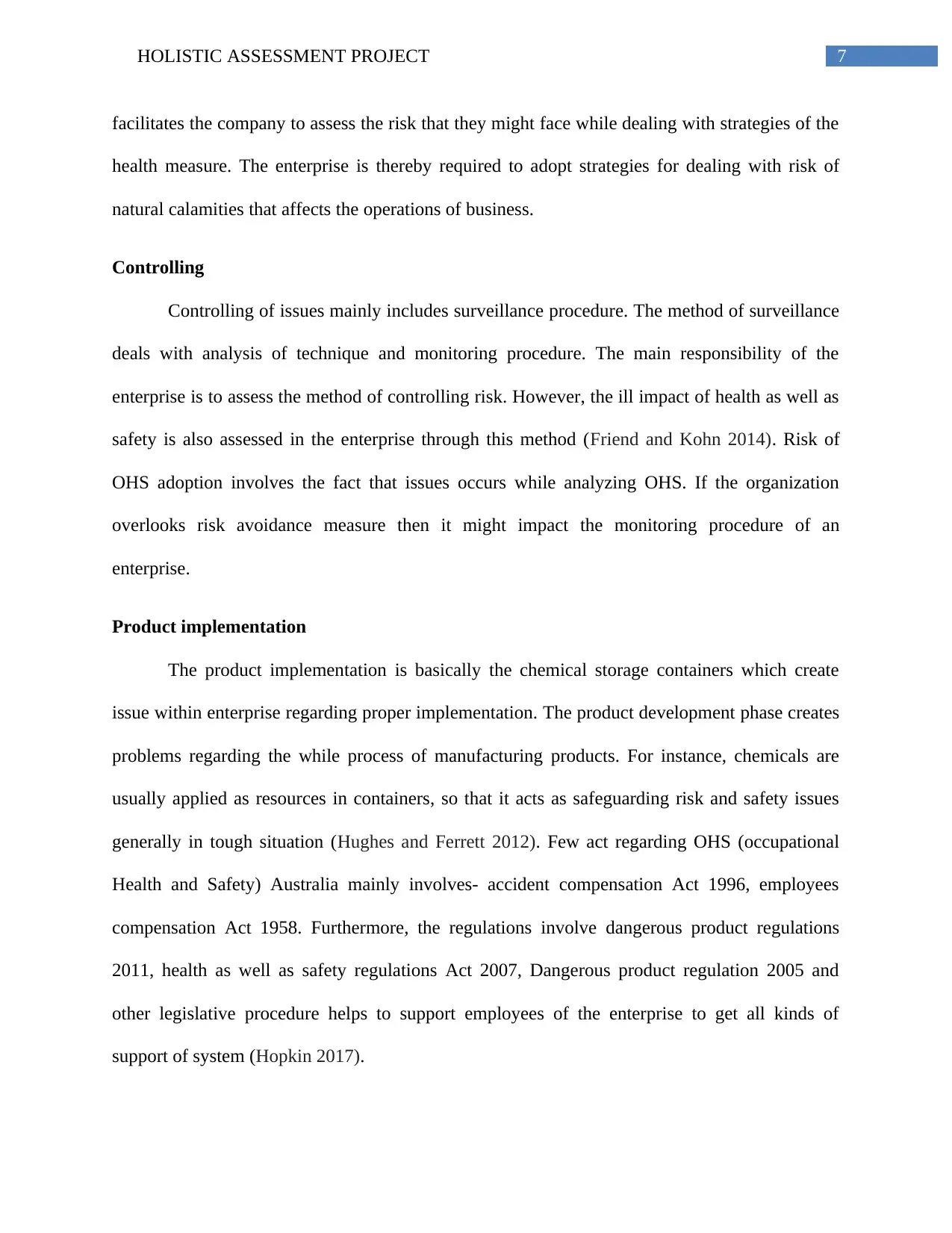
7HOLISTIC ASSESSMENT PROJECT
facilitates the company to assess the risk that they might face while dealing with strategies of the
health measure. The enterprise is thereby required to adopt strategies for dealing with risk of
natural calamities that affects the operations of business.
Controlling
Controlling of issues mainly includes surveillance procedure. The method of surveillance
deals with analysis of technique and monitoring procedure. The main responsibility of the
enterprise is to assess the method of controlling risk. However, the ill impact of health as well as
safety is also assessed in the enterprise through this method (Friend and Kohn 2014). Risk of
OHS adoption involves the fact that issues occurs while analyzing OHS. If the organization
overlooks risk avoidance measure then it might impact the monitoring procedure of an
enterprise.
Product implementation
The product implementation is basically the chemical storage containers which create
issue within enterprise regarding proper implementation. The product development phase creates
problems regarding the while process of manufacturing products. For instance, chemicals are
usually applied as resources in containers, so that it acts as safeguarding risk and safety issues
generally in tough situation (Hughes and Ferrett 2012). Few act regarding OHS (occupational
Health and Safety) Australia mainly involves- accident compensation Act 1996, employees
compensation Act 1958. Furthermore, the regulations involve dangerous product regulations
2011, health as well as safety regulations Act 2007, Dangerous product regulation 2005 and
other legislative procedure helps to support employees of the enterprise to get all kinds of
support of system (Hopkin 2017).
facilitates the company to assess the risk that they might face while dealing with strategies of the
health measure. The enterprise is thereby required to adopt strategies for dealing with risk of
natural calamities that affects the operations of business.
Controlling
Controlling of issues mainly includes surveillance procedure. The method of surveillance
deals with analysis of technique and monitoring procedure. The main responsibility of the
enterprise is to assess the method of controlling risk. However, the ill impact of health as well as
safety is also assessed in the enterprise through this method (Friend and Kohn 2014). Risk of
OHS adoption involves the fact that issues occurs while analyzing OHS. If the organization
overlooks risk avoidance measure then it might impact the monitoring procedure of an
enterprise.
Product implementation
The product implementation is basically the chemical storage containers which create
issue within enterprise regarding proper implementation. The product development phase creates
problems regarding the while process of manufacturing products. For instance, chemicals are
usually applied as resources in containers, so that it acts as safeguarding risk and safety issues
generally in tough situation (Hughes and Ferrett 2012). Few act regarding OHS (occupational
Health and Safety) Australia mainly involves- accident compensation Act 1996, employees
compensation Act 1958. Furthermore, the regulations involve dangerous product regulations
2011, health as well as safety regulations Act 2007, Dangerous product regulation 2005 and
other legislative procedure helps to support employees of the enterprise to get all kinds of
support of system (Hopkin 2017).
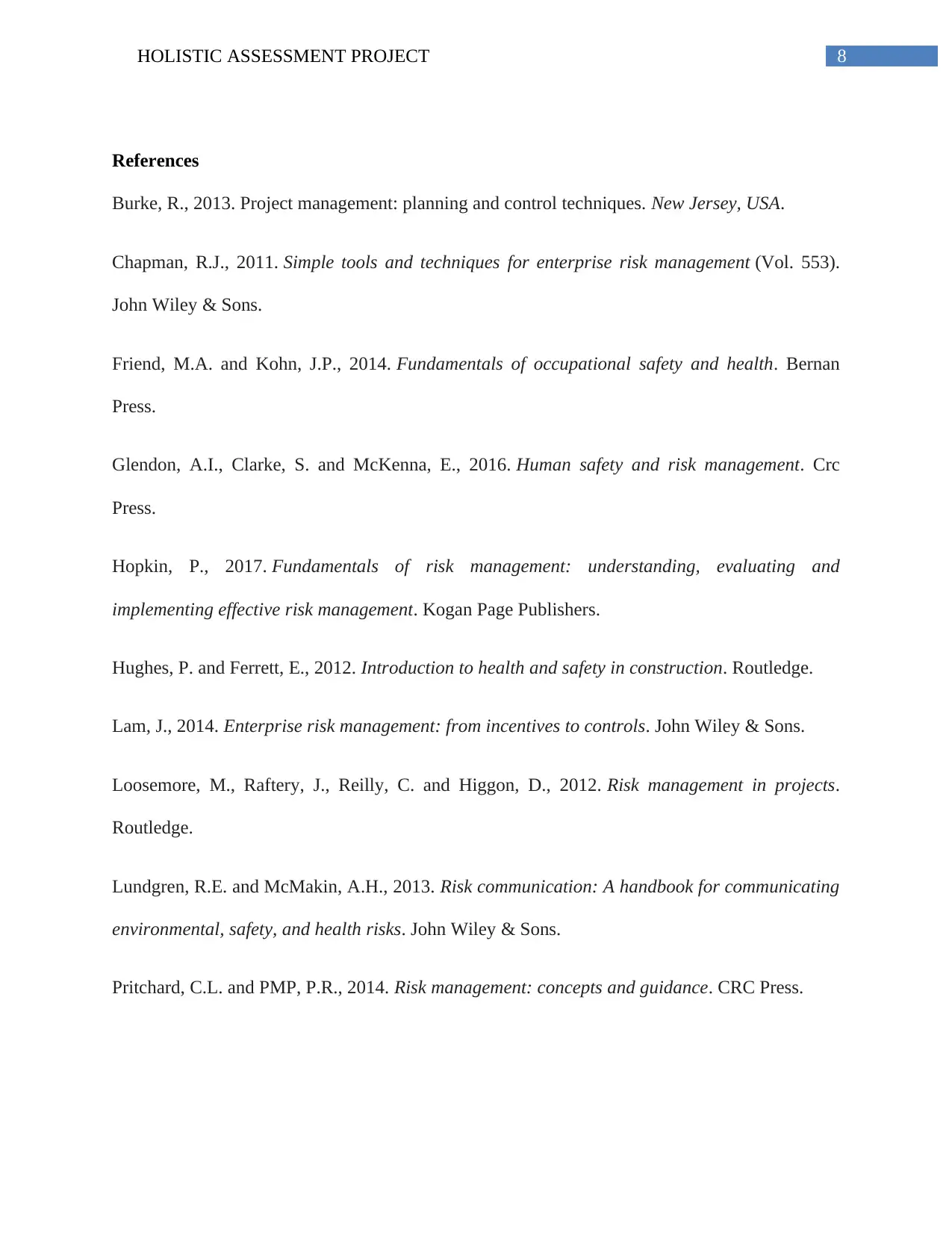
8HOLISTIC ASSESSMENT PROJECT
References
Burke, R., 2013. Project management: planning and control techniques. New Jersey, USA.
Chapman, R.J., 2011. Simple tools and techniques for enterprise risk management (Vol. 553).
John Wiley & Sons.
Friend, M.A. and Kohn, J.P., 2014. Fundamentals of occupational safety and health. Bernan
Press.
Glendon, A.I., Clarke, S. and McKenna, E., 2016. Human safety and risk management. Crc
Press.
Hopkin, P., 2017. Fundamentals of risk management: understanding, evaluating and
implementing effective risk management. Kogan Page Publishers.
Hughes, P. and Ferrett, E., 2012. Introduction to health and safety in construction. Routledge.
Lam, J., 2014. Enterprise risk management: from incentives to controls. John Wiley & Sons.
Loosemore, M., Raftery, J., Reilly, C. and Higgon, D., 2012. Risk management in projects.
Routledge.
Lundgren, R.E. and McMakin, A.H., 2013. Risk communication: A handbook for communicating
environmental, safety, and health risks. John Wiley & Sons.
Pritchard, C.L. and PMP, P.R., 2014. Risk management: concepts and guidance. CRC Press.
References
Burke, R., 2013. Project management: planning and control techniques. New Jersey, USA.
Chapman, R.J., 2011. Simple tools and techniques for enterprise risk management (Vol. 553).
John Wiley & Sons.
Friend, M.A. and Kohn, J.P., 2014. Fundamentals of occupational safety and health. Bernan
Press.
Glendon, A.I., Clarke, S. and McKenna, E., 2016. Human safety and risk management. Crc
Press.
Hopkin, P., 2017. Fundamentals of risk management: understanding, evaluating and
implementing effective risk management. Kogan Page Publishers.
Hughes, P. and Ferrett, E., 2012. Introduction to health and safety in construction. Routledge.
Lam, J., 2014. Enterprise risk management: from incentives to controls. John Wiley & Sons.
Loosemore, M., Raftery, J., Reilly, C. and Higgon, D., 2012. Risk management in projects.
Routledge.
Lundgren, R.E. and McMakin, A.H., 2013. Risk communication: A handbook for communicating
environmental, safety, and health risks. John Wiley & Sons.
Pritchard, C.L. and PMP, P.R., 2014. Risk management: concepts and guidance. CRC Press.
⊘ This is a preview!⊘
Do you want full access?
Subscribe today to unlock all pages.

Trusted by 1+ million students worldwide
1 out of 9
Related Documents
Your All-in-One AI-Powered Toolkit for Academic Success.
+13062052269
info@desklib.com
Available 24*7 on WhatsApp / Email
![[object Object]](/_next/static/media/star-bottom.7253800d.svg)
Unlock your academic potential
Copyright © 2020–2025 A2Z Services. All Rights Reserved. Developed and managed by ZUCOL.





